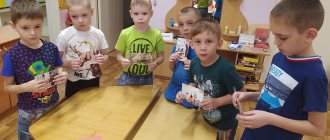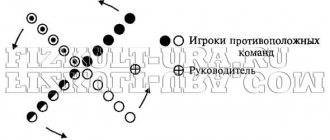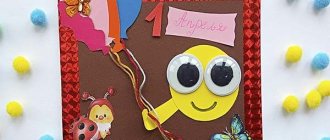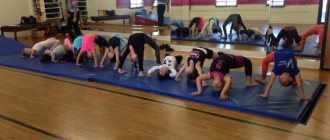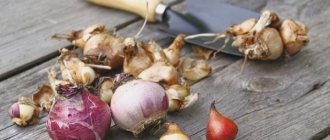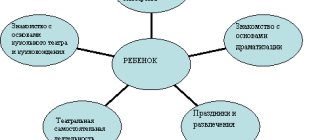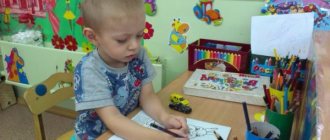Cyclogram of interaction between a teacher and a junior teacher during the day
| Time | Responsibilities of the teacher | Responsibilities of a junior teacher |
| 7.00 – 8.15 | Receives children in a group, conducts conversations with parents, organizes children's play activities. Prepares manuals for GCD | Conducts wet cleaning in a group. |
| 8.15 – 8.30 | Conducts morning exercises. Leads children to wash their hands before breakfast | Receives breakfast, organizes the work of those on duty to serve the table, sets the tables, introduces the children to the breakfast menu. Greets children after washing their hands, helps them sit down at the table |
| 8.30 – 9.00 | Breakfast Guides the process of eating: monitors children, teaches how to use cutlery and napkins correctly. Encourages those on duty to introduce children to the names of breakfast dishes | Helps children with breakfast. Is washing dishes. Supervises the work of the duty officers. Conducts wet cleaning in the music/gym hall |
| 9.00-9.25 | Conducts educational activities with 1 subgroup of children | Organizes joint activities with children not involved in educational activities |
| 9.30-9.55 | Conducts ECD with 2 subgroups of children | Organizes joint activities with children not involved in educational activities |
| 10.00-10.10 | Organizes joint and independent activities of children, the work of those on duty serving tables | Gets a second breakfast |
| 10.10-10.30 | Second breakfast Leads children to wash their hands before breakfast. Manages the process of eating: monitors children, teaches how to use cutlery and napkins correctly | Helps children with breakfast. Supervises the work of the duty officers. Is washing dishes |
| 10.30-10.40 | Preparing for a walk. Leads children to the toilet. Helps children get dressed for a walk. Takes the children for a walk | Helps children get dressed for a walk. Helps the teacher take the children out for a walk (helps the children go down the stairs, brings the children to the playground) |
| 10.40-12.00 | Conducts a walk (observations, games, physical exercises, individual work) according to plan | Cleans the premises. Ventilates group rooms and bedrooms. Prepares dishes for those on duty to set tables for dinner. Gets lunch |
| 12.00-12.20 | Picks up children from a walk. Helps children undress and hang wet clothes to dry. Takes children to the toilet and ensures hand washing. Organizes the work of the canteen attendants | Meets children from their walk near the front door and escorts them to the group. Helps children walk up the stairs. Helps children undress and hang wet clothes to dry. Supervises the work of the canteen attendants |
| 12.20-12.30 | Organizes joint and independent activities for children | Receives and arranges food. Introduces children to the lunch menu |
| 12.30-13.00 | Lunch Manages the process of eating: monitors the children, teaches them how to use cutlery and napkins correctly. Encourages those on duty to introduce children to the names of dishes for lunch. After lunch, he takes the children to the toilet and helps them undress. Puts children to bed for naps | Helps children during lunch, organizes the work of those on duty in distributing the second course, cleaning dishes, wiping tables, sweeping the floors after lunch, hygiene procedures and undressing for naps |
| 13.00-15.00 | Children's sleep. Prepares for methodological events, produces manuals, engages in self-education, designing parent corners, works with documentation | Washes the dishes and the group after lunch. Conducts wet cleaning and ventilation of premises, general cleaning according to schedule. Helps the teacher in the preparation of manuals |
| 15.00-15.30 | Raises children. Conducts hardening procedures. Helps children get dressed. Leads children to the toilet, helps wash themselves | Receives the afternoon snack, involves those on duty in setting the tables for the afternoon snack, and sets the tables together with the children. Clarifies with the attendants the names of dishes for the afternoon snack. Makes beds, mops bedroom floors |
| 15.30-15.50 | Afternoon snack Manages the process of eating: involves those on duty in introducing the children to the names of dishes for the afternoon snack, monitors the children, teaches them how to use cutlery and napkins correctly. | Washes dishes and group after meals |
| 15.55-16.20 | Conducts GCD | Organizes joint activities with children not involved in educational activities |
| 16.20-16.30 | Helps children get dressed for a walk. Takes the children for a walk | Helps children get dressed for a walk. Helps the teacher take the children out for a walk (helps the children go down the stairs, brings the children to the playground) |
| 16.30-17.15 | Takes a walk | End of the working day |
| 17.15-17.30 | Picks up children from a walk. Helps children undress, hangs wet clothes to dry. Takes children to the toilet and ensures hand washing. Organizes the work of the canteen attendants and supervises their work. Introduces names of dishes | |
| 17.30-18.00 | Dinner. Manages the process of eating: monitors children, teaches how to use cutlery and napkins correctly. Supervises the work of the dining room attendants after the children have eaten (collecting dishes, sweeping crumbs from the table, sweeping the floor around the tables) | |
| 18.00-19.00 | Organizes joint and independent activities of children. Summing up the day spent with the children. Conducts assessments and self-assessments of the work of those on duty, filling out a calendar of good deeds, etc. |
6. Monitoring of individual development of children (monitoring criteria and indicators, frequency)
Criteria (using the example of variable educational programs of preschool education “Childhood” and “Our Home - Southern Urals”, MDOU No. 137):
1. NGO “Social and communicative development”. Criteria: the world of social relations, value-based attitude to work, play, safe behavior in everyday life, society, nature.
2. NGO “Cognitive Development”. Criteria: development of sensory culture; first steps in mathematics; primary idea of oneself and other people; the child discovers the natural world; primary idea of the small Motherland and Fatherland.
3. NGO “Speech Development”. Criteria: coherent speech (monologue and dialogic); grammatical structure of speech; development of speech creativity; speech as a means of communication and culture; book culture, children's literature; the formation of sound analytical-synthetic activity as a prerequisite for learning to read and write.
4. NGO “Artistic and Aesthetic Development”. Criteria: fine arts; presentation and experience of works of art; productive activity and children's creativity; collective creative work; recognition, understanding, analysis of the nature of music; mastery of vocal techniques; motor abilities; use of sound sensory standards.
5. NGO “Physical Development”. Criteria: motor activity; development of healthy lifestyle values in children, mastery of its elementary norms and rules.
Indicators using the example of the NGO “Social and Communicative Development” (junior group).
| The world of social relations | Value-based attitude to work | A game | Safe behavior in everyday life, society, nature | ||||||
| Emotions | Relationships | Culture of behavior, communication with adults and peers | Family | Adult labor | Self-service | Role-playing | Director's | Didactic | |
| - understands and distinguishes separately pronounced emotional states of people (joy, anger, tears, fun); - takes into account the emotional state in communication with the support, encouragement or demonstration of an adult: to have pity, treat, treat affectionately | -has an idea of the actions and deeds of adults and children, which show kindness and care for people, family members, animals, plants; — masters simple ways of communication and interaction: enters into pair communication, addresses children by name, agrees on joint actions; -participates in joint play and everyday activities with the teacher, is ready to answer his questions, acts in a coordinated manner, takes into account the advice and suggestions of the teacher | -has an idea of the basic rules of cultural behavior, practices their implementation (says hello, says goodbye, thanks); - understands that all children have equal rights to toys, that in kindergarten boys and girls treat each other kindly, share toys, and do not offend each other | - has an idea about the family, family members, their relationships (parents and children love each other, take care of each other); — answers questions about his family, about joyful family events. | -has the initial idea that objects are made by people; — together with an adult, establishes the “goal-result” relationship in work; - in the process of observation, has an idea of the household work of adults at home and in kindergarten; interested in the actions of washing dishes, washing floors, wiping dust, sweeping paths. | - masters individual self-service actions related to dressing, washing, caring for one’s appearance, and behavior at the table during meals; — learns to maintain order (does not litter, puts toys and building materials back in place, tries to be neat). | -shows interest in the varied content of role-playing games based on the display of family relationships, direct impressions from visiting a store, a clinic, events from books read, cartoons, pictures; - knows how to assume a game role, participate in simple role-playing dialogue, name his game role and game actions, answer questions about the game; - takes the initiative to complement the game environment, uses substitute items and costume details; - with the support and help of the teacher, enters into playful communication with peers; in the second half of the year - independently negotiates with peers to perform familiar game actions in the general game plot | -participates in director's games based on the plots of fairy tales, poems, animated films, simple illustrations and pictures; - shows scenes using toys, performing simple game tasks; -shows a desire to answer the teacher’s questions about what is happening in the game, what will happen next, actively responds to the appearance of a new game character, to problematic situations | -together with the teacher participates in games with objects, educational toys, and pictures; - is able to identify various sensory features in objects and their images (color, size, shape); -identify several features in an object; - with the help of the teacher, accepts the game task; -performs actions in a certain sequence; -begins to act on a signal, act according to a model and in accordance with the game task, understands simple schemes | -masters an understanding of the basic rules for safe handling of toys and objects in play, at the table, while dressing, and in communicating with children; — in nature: do not approach homeless animals, do not frighten them, do not crush flowers; Do not eat berries, plant leaves, or leave the kindergarten area without the permission of your elders. |
Applications
a. Calendar plan of the educational process (MDOU No. 105)
Group____ Age____ Topic_________________________________________________________________________________________
Target _________________________________________________________________________________________________________________
Final event_______________________________________________ Date of the final event_________________
Responsible for the final event______________________________________________________________________________
| Day of the week | Mode | Joint activities of adults and children, taking into account the integration of educational areas | Organization of a developmental environment for children’s independent activities (activity centers, all group rooms) | Interaction with parents/social partners (theaters, sports, art schools, educational institutions) | |
| Group, subgroup | Individual | Educational activities in special moments | |||
| Morning: games, duty, individual work, errands, morning exercises, group exercise, breakfast, games | Morning gymnastics; didactic games, reading art. literature; conversation; educational games; articulation and finger gymnastics | Conversation; imitative movements; educational games. Reinforcement of material in educational areas | Explanation, demonstration, personal example, reminder, situational conversation | Enrichment of the subject-development environment in the group. Encouraging children to engage in independent activities in centers: books, nature, art; duty roster; role-playing games; self-service; modeling; keeping a nature calendar | Conversations, consultations (individual, group, subgroup). Joint holidays, leisure, activities. Excursions, observations, reading. Collaborative creativity. Organization of joint work activities (work in nature, in a group) - subbotniks. Family creative projects, presentations, competitions, intellectual marathon. Parent meetings, living rooms, parent clubs, seminars, open viewings, master classes. Seminars and workshops. Game educational programs. Questioning. Interactive interaction through the preschool educational institution website. Decoration of parent corners. Booklets, information sheets. Photo albums. Excursions with children. Reading to children, learning by heart. Excursions to schools, creative houses. Showing puppet theater performances |
| Direct educational activities | (scheduled classes) Indicates the activities and a summary of the classes | ||||
| Games. Walk: games, observations, work, individual work, physical education and recreational work | Outdoor games, sports games, outdoor physical education. Observations of living and inanimate objects. Targeted walks, excursions. Work on the site, in the flower garden, vegetable garden | Conversation; imitative movements; educational games. Consolidation of what has been completed in educational areas | Role-playing game, observation, experimentation, research, construction, educational games, story, conversation, creating collections, project activities, problem situations, making mock-ups, modeling, comparison, explanation, showing, personal example, situational conversation | Enrichment of the subject-developmental environment in the group, on the site. Role-playing, didactic, board and printed games. Games with sand (with snow). Experimentation (sand, water, snow, wind). Modeling. Experiments. Productive activity | |
| Return from a walk, KGN, lunch, work before bed | Reading fiction | Independent activity of children in activity centers | Independent activity of children in various activity centers | ||
| Evening: health and conditioning procedures, physical training, afternoon snack, games, independent activities for children, leisure, clubs, individual work | Gymnastics after sleep, hardening. Mugs. Role-playing, didactic, leisure games. Reading fiction, video viewings. Quizzes, competitions, KVN. Collaborative work of children. Exhibitions. Dramatizations. Show performances | Conversation; imitative movements; educational games. Reinforcement of material in educational areas | Enrichment of the subject-development environment in the group. Experimentation games, amateur story-based, didactic, board and printed games. Independent artistic activity, creative tasks; duty; maintaining a nature calendar. Work in the centers: nature, books, artistic creativity. Experiments. Buildings for story games. Productive activity | ||
| Walk | All events are planned in the same way as in the first half of the day |
And so on until the end of the week.
PRESENTATION OPTION – Calendar plan of the educational process (topic “Folk culture and traditions”, 1st junior group, MDOU No. 31)
Tasks:
1. Familiarize children with household items, their names, and purposes.
2. Develop the ability to distinguish household items in pictures and name them (washstand, stove, cast iron, grab, poker, samovar, rocker, bucket, trough, washboard, clay pot).
3. Familiarization with folk art using the example of folk toys.
| Interaction with parents/social partners (theaters, sports, art schools, educational institutions) | Organization of a developmental environment for children’s independent activities (activity centers, all group rooms and street areas) |
| — Didactic games with matryoshka dolls; — visiting museums; exhibitions of folk life; - home reading, familiarity with oral folk art (songs, nursery rhymes, etc.); — task: invite parents and their children to bake a sweet treat for grandparents; — recommend that parents introduce children to folk art using the example of folk toys (matryoshka dolls, tumbler); — task: invite parents to take a walk with their children to the park, pay attention to the wooden sculptures (houses) | — mini-museum of nesting dolls; - objects to enrich sound sensory experience, experience of manipulating objects; - objects for decorating, tracing along the contour (washstand, stove, cast iron pot, grip, poker, samovar, rocker, bucket, trough, washboard, clay pot); - flat figures for flannelgraph, for playing out familiar nursery rhymes and fairy tales and activating speech; - cut out stencils of clothes and figurines for decorating them; — folk art items, illustrations, albums, photographs; — books of fairy tales with illustrations, a toy book, a picture book, a panorama book; - illustrations for the fairy tales “Turnip”, “Kolobok”, “Three Bears”, “Masha and the Bear”, “Teremok”, “Rock Hill”, “Cat, Fox and Rooster”, “Zayushkina’s Hut” for viewing; — introducing new equipment: cast iron, grip, poker, stove; - sundresses, scarves; — illustrations for the fairy tales “Ryaba Hen”, “Turnip”; - samples of painted clothing (shirt and pants for a boy, sundress and kokoshnik for a girl) |
Monday
| Structural components of the regime | Educational areas | Joint activities of adults and children in regime processes | ||
| Group, subgroup | Individual | Hygiene procedures, feeding, packing for walks | ||
| Morning | Physical development, speech development, cognitive development | Morning exercises. Games with matryoshka dolls. Collect nesting dolls according to size. S/r game “House” - teach children how to use toy dishes correctly | Review the rules of conduct in kindergarten (You can’t put foreign objects in your mouth, you can’t run around tables, etc.) with Danil, Artem, Anya | Continue to teach children to eat carefully and not throw crumbs on the floor. “The legs don’t stand still, and all the crumbs fly to the floor.” |
| OOD | Artistic and aesthetic development | 08.45 -09.00. Music: Learn to show emotional responsiveness when listening to a song. Be active when singing along, perform simple dance movements. Listening and comparing the sounds of different pieces of music (lullaby and march). Improvisational dance to the music of S. Maykapor “Dance with leaves” (children choose only a certain color from the proposed leaves and dance with them) | ||
| Walk | Social and communicative development, cognitive development, physical development | Card No. 1 “Getting to know the territory.” Goal: To pay special attention to the emotional state of children. Relieve feelings of anxiety and negativism. Continue introducing the area for daily walks | Low mobility games for the development of basic movements with Danil, Regina, Makar | Teaching children how to dress and undress |
| After the walk | Social and communicative development, speech development | Reading the Russian folk tale "Teremok" | ||
| OOD | Physical development, speech development, cognitive development | Health-improving gymnastics after sleep. Walking barefoot on massage mats. Looking at picture books “Pets”. To consolidate knowledge of the sounds made by animals: goat, horse, cow - “MU, MU”, etc. Didactic game “What does it sound like?” | Continue learning the nursery rhyme “Like our cat” with Nastya, Omina, Anya | Situational conversation “Why you need to wash your hands” |
| Artistic and aesthetic development | 1 subgroup: 15.45-15.55; 2 subgroup: 16.05-16.15. Drawing: “Let’s make a pattern on the cup.” Improve your pencil drawing skills. Try to paint the pattern on the cup evenly, without going beyond the outline of the pattern. Develop visual perception and finger motor skills | |||
| Walk | Physical development, cognitive development, speech development | A targeted walk around the territory of the kindergarten “Trees are our friends.” Imitation games “Where are our hands?” Outdoor game: “At the bear in the forest” |
PRESENTATION OPTION – Calendar plan of the educational process (September, topic “Day of Knowledge”, 1st week, preparatory group for school, MDOU No. 25)
Objectives: 1. Development of cognitive interest, interest in school, books.
2. Consolidating children’s knowledge about school, school supplies, the profession of a teacher (who teaches what at school, subjects studied at school).
3. Formation of friendly relationships between children (habits of playing together, working together, doing independently chosen activities, negotiating, distributing responsibilities, helping each other).
Final event: Travel game “On the road to the land of Knowledge”
2
Recommended pages:
Use the site search:
